Comprehensive Report: UK Housing Market during 2009-2019
VerifiedAdded on 2023/01/10
|13
|3613
|72
Report
AI Summary
This report provides a comprehensive analysis of the UK housing market, focusing on the period between 2009 and 2019. It examines the fluctuations in average house prices, identifying key trends and patterns. The report delves into the economic determinants that influence these price changes, including factors related to both demand and supply, such as economic growth, income levels, population, and the number of suppliers. It also investigates the impact of government actions, such as interventions in interest rates and the abolishment of stamp duty, on the housing market. Finally, the report explores the predicted impact of the COVID-19 pandemic on the UK housing market. The analysis provides valuable insights into the dynamics of the UK housing market and the factors that shape its performance.

UK Housing Market
Paraphrase This Document
Need a fresh take? Get an instant paraphrase of this document with our AI Paraphraser
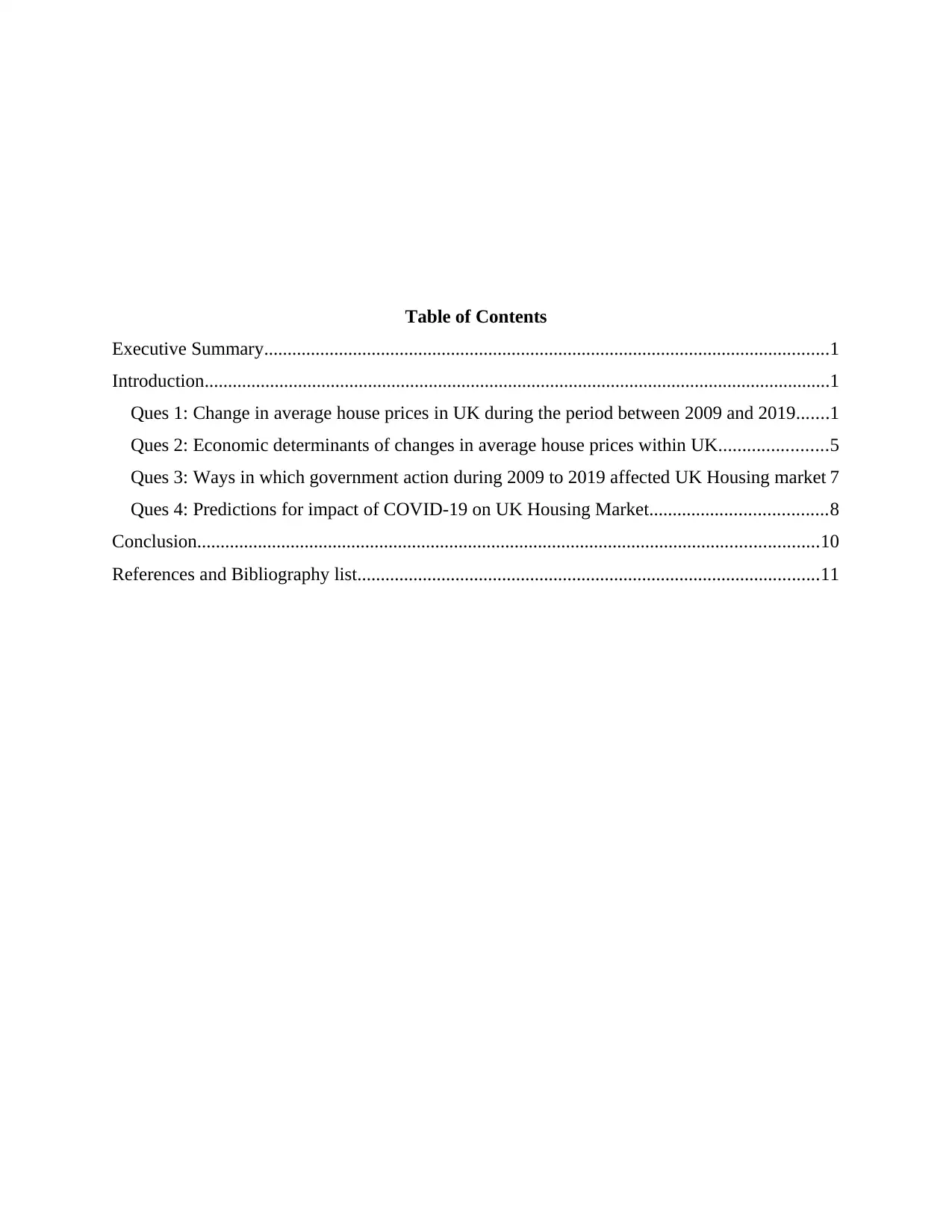
Table of Contents
Executive Summary.........................................................................................................................1
Introduction......................................................................................................................................1
Ques 1: Change in average house prices in UK during the period between 2009 and 2019.......1
Ques 2: Economic determinants of changes in average house prices within UK.......................5
Ques 3: Ways in which government action during 2009 to 2019 affected UK Housing market 7
Ques 4: Predictions for impact of COVID-19 on UK Housing Market......................................8
Conclusion.....................................................................................................................................10
References and Bibliography list...................................................................................................11
Executive Summary.........................................................................................................................1
Introduction......................................................................................................................................1
Ques 1: Change in average house prices in UK during the period between 2009 and 2019.......1
Ques 2: Economic determinants of changes in average house prices within UK.......................5
Ques 3: Ways in which government action during 2009 to 2019 affected UK Housing market 7
Ques 4: Predictions for impact of COVID-19 on UK Housing Market......................................8
Conclusion.....................................................................................................................................10
References and Bibliography list...................................................................................................11
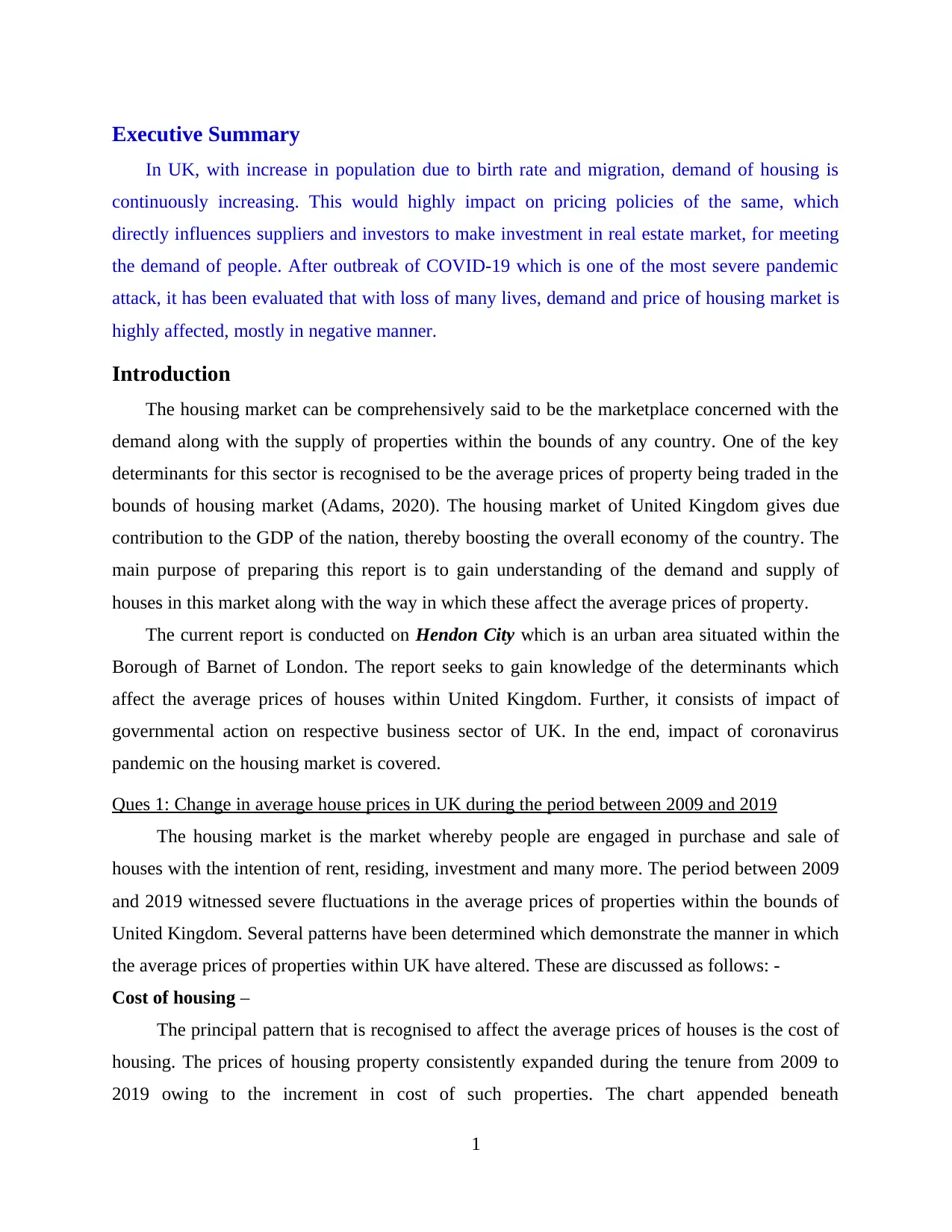
Executive Summary
In UK, with increase in population due to birth rate and migration, demand of housing is
continuously increasing. This would highly impact on pricing policies of the same, which
directly influences suppliers and investors to make investment in real estate market, for meeting
the demand of people. After outbreak of COVID-19 which is one of the most severe pandemic
attack, it has been evaluated that with loss of many lives, demand and price of housing market is
highly affected, mostly in negative manner.
Introduction
The housing market can be comprehensively said to be the marketplace concerned with the
demand along with the supply of properties within the bounds of any country. One of the key
determinants for this sector is recognised to be the average prices of property being traded in the
bounds of housing market (Adams, 2020). The housing market of United Kingdom gives due
contribution to the GDP of the nation, thereby boosting the overall economy of the country. The
main purpose of preparing this report is to gain understanding of the demand and supply of
houses in this market along with the way in which these affect the average prices of property.
The current report is conducted on Hendon City which is an urban area situated within the
Borough of Barnet of London. The report seeks to gain knowledge of the determinants which
affect the average prices of houses within United Kingdom. Further, it consists of impact of
governmental action on respective business sector of UK. In the end, impact of coronavirus
pandemic on the housing market is covered.
Ques 1: Change in average house prices in UK during the period between 2009 and 2019
The housing market is the market whereby people are engaged in purchase and sale of
houses with the intention of rent, residing, investment and many more. The period between 2009
and 2019 witnessed severe fluctuations in the average prices of properties within the bounds of
United Kingdom. Several patterns have been determined which demonstrate the manner in which
the average prices of properties within UK have altered. These are discussed as follows: -
Cost of housing –
The principal pattern that is recognised to affect the average prices of houses is the cost of
housing. The prices of housing property consistently expanded during the tenure from 2009 to
2019 owing to the increment in cost of such properties. The chart appended beneath
1
In UK, with increase in population due to birth rate and migration, demand of housing is
continuously increasing. This would highly impact on pricing policies of the same, which
directly influences suppliers and investors to make investment in real estate market, for meeting
the demand of people. After outbreak of COVID-19 which is one of the most severe pandemic
attack, it has been evaluated that with loss of many lives, demand and price of housing market is
highly affected, mostly in negative manner.
Introduction
The housing market can be comprehensively said to be the marketplace concerned with the
demand along with the supply of properties within the bounds of any country. One of the key
determinants for this sector is recognised to be the average prices of property being traded in the
bounds of housing market (Adams, 2020). The housing market of United Kingdom gives due
contribution to the GDP of the nation, thereby boosting the overall economy of the country. The
main purpose of preparing this report is to gain understanding of the demand and supply of
houses in this market along with the way in which these affect the average prices of property.
The current report is conducted on Hendon City which is an urban area situated within the
Borough of Barnet of London. The report seeks to gain knowledge of the determinants which
affect the average prices of houses within United Kingdom. Further, it consists of impact of
governmental action on respective business sector of UK. In the end, impact of coronavirus
pandemic on the housing market is covered.
Ques 1: Change in average house prices in UK during the period between 2009 and 2019
The housing market is the market whereby people are engaged in purchase and sale of
houses with the intention of rent, residing, investment and many more. The period between 2009
and 2019 witnessed severe fluctuations in the average prices of properties within the bounds of
United Kingdom. Several patterns have been determined which demonstrate the manner in which
the average prices of properties within UK have altered. These are discussed as follows: -
Cost of housing –
The principal pattern that is recognised to affect the average prices of houses is the cost of
housing. The prices of housing property consistently expanded during the tenure from 2009 to
2019 owing to the increment in cost of such properties. The chart appended beneath
1
⊘ This is a preview!⊘
Do you want full access?
Subscribe today to unlock all pages.

Trusted by 1+ million students worldwide
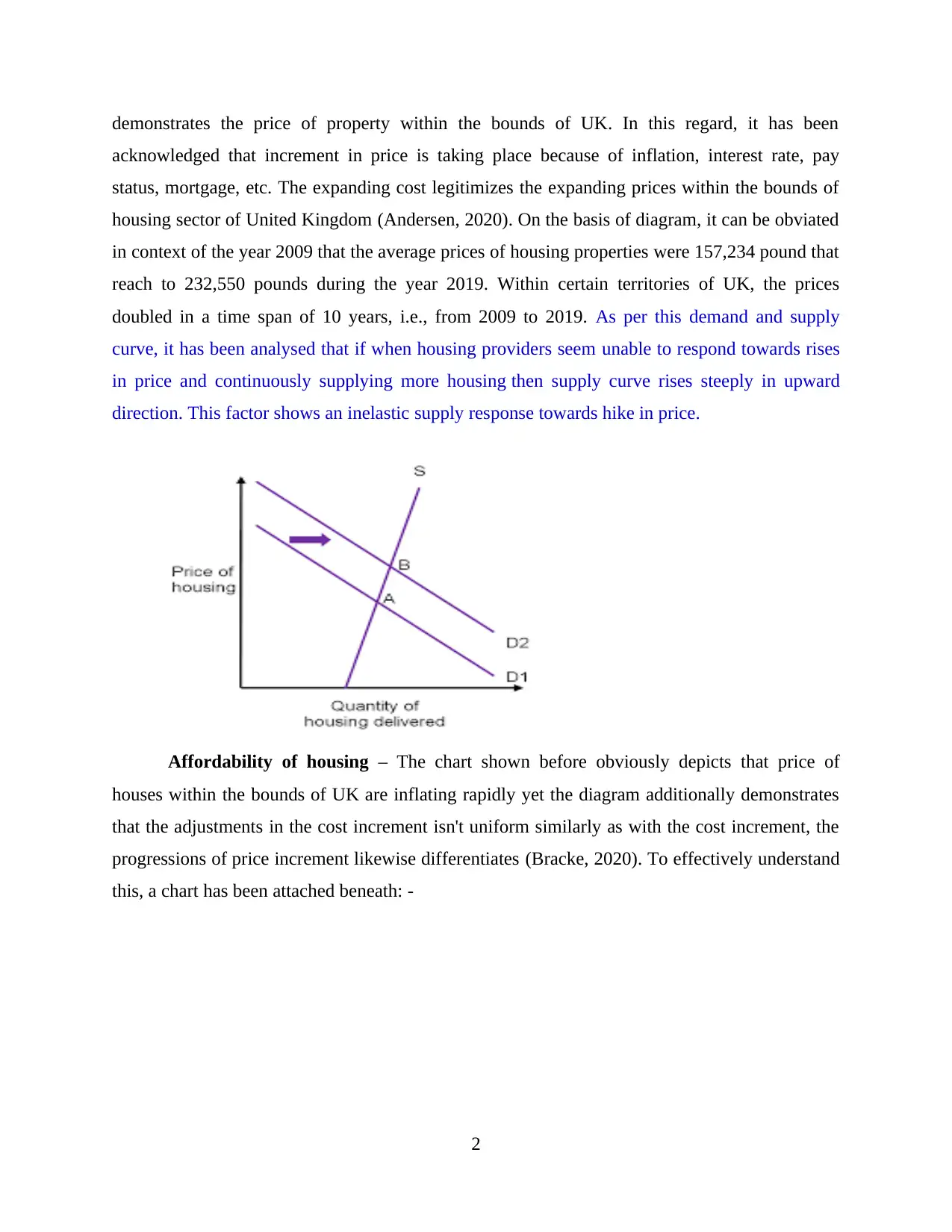
demonstrates the price of property within the bounds of UK. In this regard, it has been
acknowledged that increment in price is taking place because of inflation, interest rate, pay
status, mortgage, etc. The expanding cost legitimizes the expanding prices within the bounds of
housing sector of United Kingdom (Andersen, 2020). On the basis of diagram, it can be obviated
in context of the year 2009 that the average prices of housing properties were 157,234 pound that
reach to 232,550 pounds during the year 2019. Within certain territories of UK, the prices
doubled in a time span of 10 years, i.e., from 2009 to 2019. As per this demand and supply
curve, it has been analysed that if when housing providers seem unable to respond towards rises
in price and continuously supplying more housing then supply curve rises steeply in upward
direction. This factor shows an inelastic supply response towards hike in price.
Affordability of housing – The chart shown before obviously depicts that price of
houses within the bounds of UK are inflating rapidly yet the diagram additionally demonstrates
that the adjustments in the cost increment isn't uniform similarly as with the cost increment, the
progressions of price increment likewise differentiates (Bracke, 2020). To effectively understand
this, a chart has been attached beneath: -
2
acknowledged that increment in price is taking place because of inflation, interest rate, pay
status, mortgage, etc. The expanding cost legitimizes the expanding prices within the bounds of
housing sector of United Kingdom (Andersen, 2020). On the basis of diagram, it can be obviated
in context of the year 2009 that the average prices of housing properties were 157,234 pound that
reach to 232,550 pounds during the year 2019. Within certain territories of UK, the prices
doubled in a time span of 10 years, i.e., from 2009 to 2019. As per this demand and supply
curve, it has been analysed that if when housing providers seem unable to respond towards rises
in price and continuously supplying more housing then supply curve rises steeply in upward
direction. This factor shows an inelastic supply response towards hike in price.
Affordability of housing – The chart shown before obviously depicts that price of
houses within the bounds of UK are inflating rapidly yet the diagram additionally demonstrates
that the adjustments in the cost increment isn't uniform similarly as with the cost increment, the
progressions of price increment likewise differentiates (Bracke, 2020). To effectively understand
this, a chart has been attached beneath: -
2
Paraphrase This Document
Need a fresh take? Get an instant paraphrase of this document with our AI Paraphraser
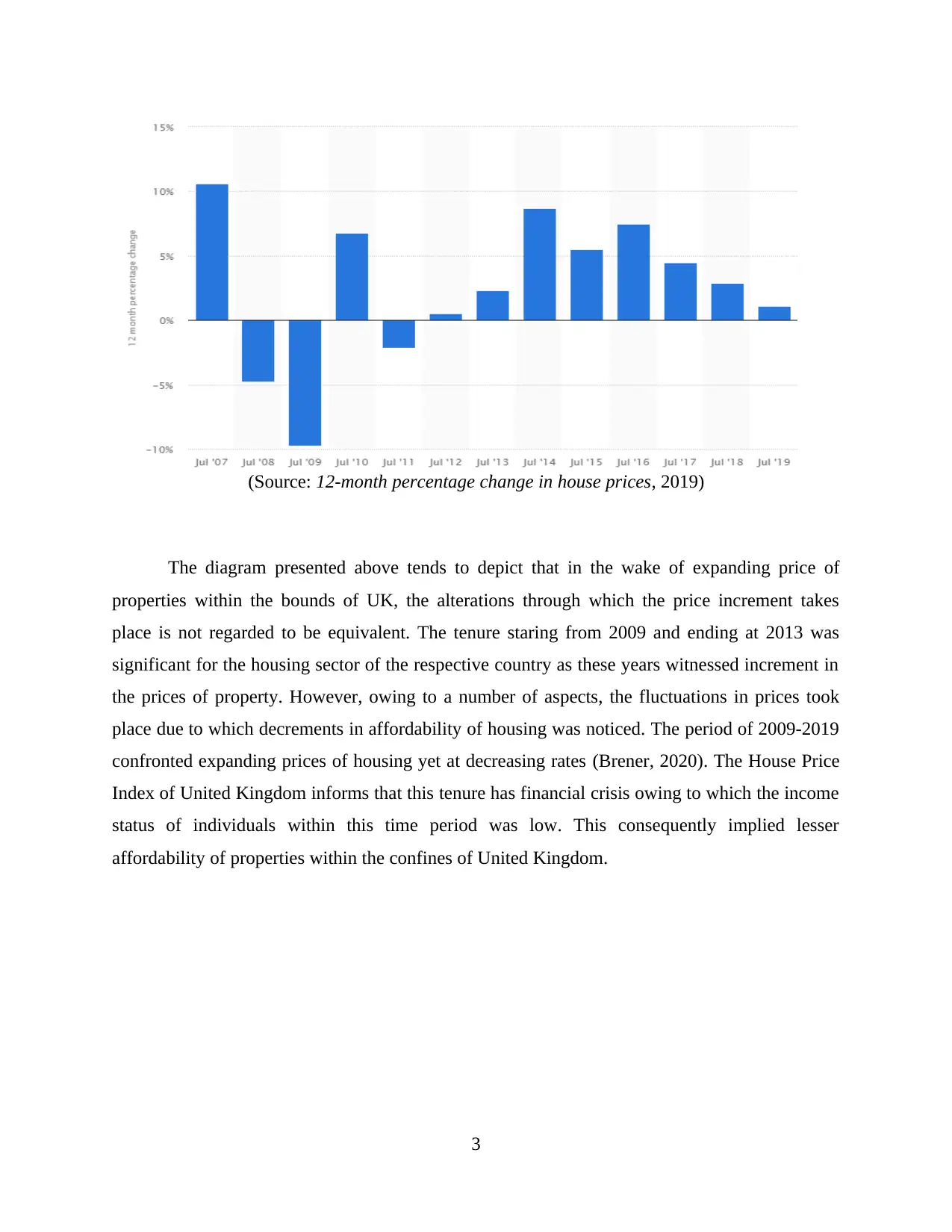
(Source: 12-month percentage change in house prices, 2019)
The diagram presented above tends to depict that in the wake of expanding price of
properties within the bounds of UK, the alterations through which the price increment takes
place is not regarded to be equivalent. The tenure staring from 2009 and ending at 2013 was
significant for the housing sector of the respective country as these years witnessed increment in
the prices of property. However, owing to a number of aspects, the fluctuations in prices took
place due to which decrements in affordability of housing was noticed. The period of 2009-2019
confronted expanding prices of housing yet at decreasing rates (Brener, 2020). The House Price
Index of United Kingdom informs that this tenure has financial crisis owing to which the income
status of individuals within this time period was low. This consequently implied lesser
affordability of properties within the confines of United Kingdom.
3
The diagram presented above tends to depict that in the wake of expanding price of
properties within the bounds of UK, the alterations through which the price increment takes
place is not regarded to be equivalent. The tenure staring from 2009 and ending at 2013 was
significant for the housing sector of the respective country as these years witnessed increment in
the prices of property. However, owing to a number of aspects, the fluctuations in prices took
place due to which decrements in affordability of housing was noticed. The period of 2009-2019
confronted expanding prices of housing yet at decreasing rates (Brener, 2020). The House Price
Index of United Kingdom informs that this tenure has financial crisis owing to which the income
status of individuals within this time period was low. This consequently implied lesser
affordability of properties within the confines of United Kingdom.
3
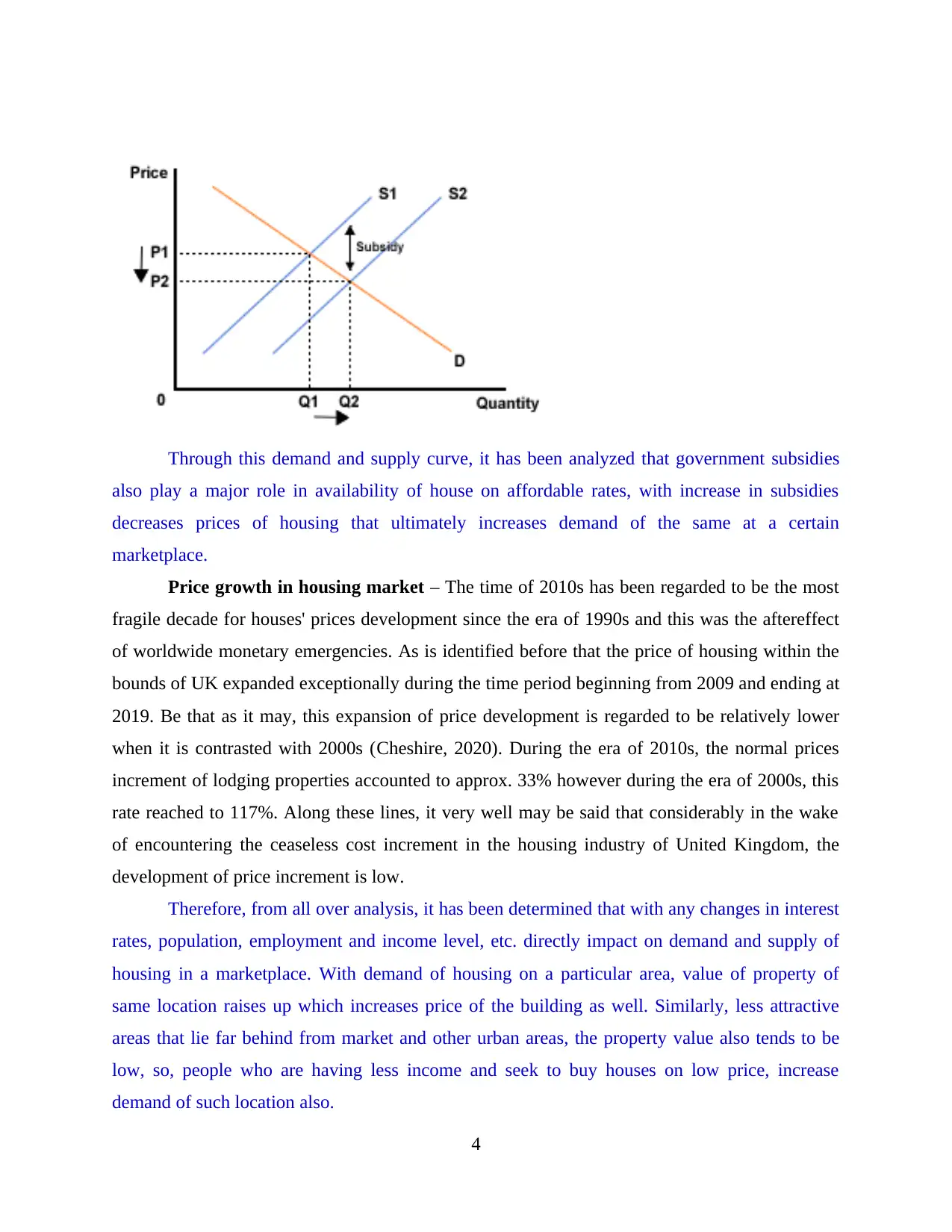
Through this demand and supply curve, it has been analyzed that government subsidies
also play a major role in availability of house on affordable rates, with increase in subsidies
decreases prices of housing that ultimately increases demand of the same at a certain
marketplace.
Price growth in housing market – The time of 2010s has been regarded to be the most
fragile decade for houses' prices development since the era of 1990s and this was the aftereffect
of worldwide monetary emergencies. As is identified before that the price of housing within the
bounds of UK expanded exceptionally during the time period beginning from 2009 and ending at
2019. Be that as it may, this expansion of price development is regarded to be relatively lower
when it is contrasted with 2000s (Cheshire, 2020). During the era of 2010s, the normal prices
increment of lodging properties accounted to approx. 33% however during the era of 2000s, this
rate reached to 117%. Along these lines, it very well may be said that considerably in the wake
of encountering the ceaseless cost increment in the housing industry of United Kingdom, the
development of price increment is low.
Therefore, from all over analysis, it has been determined that with any changes in interest
rates, population, employment and income level, etc. directly impact on demand and supply of
housing in a marketplace. With demand of housing on a particular area, value of property of
same location raises up which increases price of the building as well. Similarly, less attractive
areas that lie far behind from market and other urban areas, the property value also tends to be
low, so, people who are having less income and seek to buy houses on low price, increase
demand of such location also.
4
also play a major role in availability of house on affordable rates, with increase in subsidies
decreases prices of housing that ultimately increases demand of the same at a certain
marketplace.
Price growth in housing market – The time of 2010s has been regarded to be the most
fragile decade for houses' prices development since the era of 1990s and this was the aftereffect
of worldwide monetary emergencies. As is identified before that the price of housing within the
bounds of UK expanded exceptionally during the time period beginning from 2009 and ending at
2019. Be that as it may, this expansion of price development is regarded to be relatively lower
when it is contrasted with 2000s (Cheshire, 2020). During the era of 2010s, the normal prices
increment of lodging properties accounted to approx. 33% however during the era of 2000s, this
rate reached to 117%. Along these lines, it very well may be said that considerably in the wake
of encountering the ceaseless cost increment in the housing industry of United Kingdom, the
development of price increment is low.
Therefore, from all over analysis, it has been determined that with any changes in interest
rates, population, employment and income level, etc. directly impact on demand and supply of
housing in a marketplace. With demand of housing on a particular area, value of property of
same location raises up which increases price of the building as well. Similarly, less attractive
areas that lie far behind from market and other urban areas, the property value also tends to be
low, so, people who are having less income and seek to buy houses on low price, increase
demand of such location also.
4
⊘ This is a preview!⊘
Do you want full access?
Subscribe today to unlock all pages.

Trusted by 1+ million students worldwide
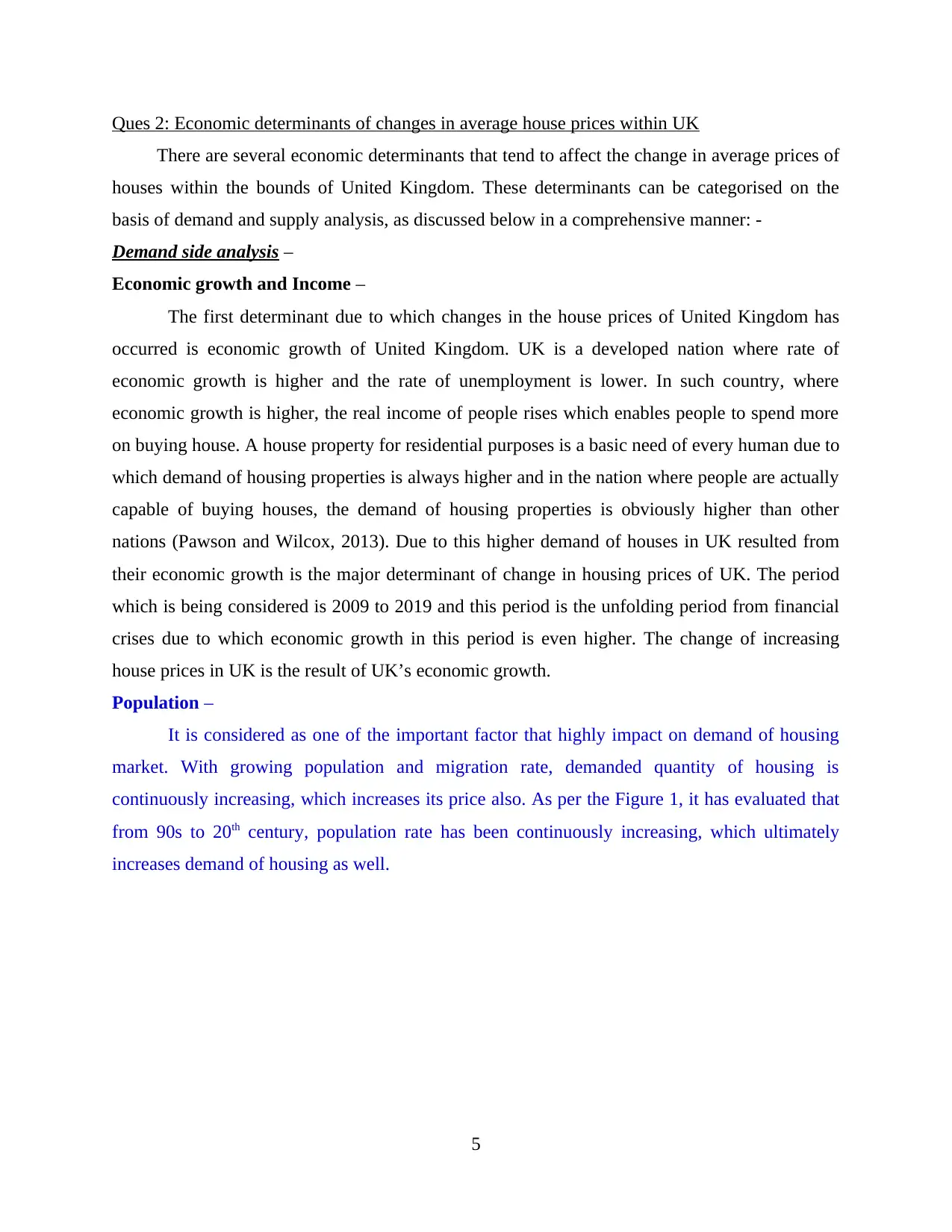
Ques 2: Economic determinants of changes in average house prices within UK
There are several economic determinants that tend to affect the change in average prices of
houses within the bounds of United Kingdom. These determinants can be categorised on the
basis of demand and supply analysis, as discussed below in a comprehensive manner: -
Demand side analysis –
Economic growth and Income –
The first determinant due to which changes in the house prices of United Kingdom has
occurred is economic growth of United Kingdom. UK is a developed nation where rate of
economic growth is higher and the rate of unemployment is lower. In such country, where
economic growth is higher, the real income of people rises which enables people to spend more
on buying house. A house property for residential purposes is a basic need of every human due to
which demand of housing properties is always higher and in the nation where people are actually
capable of buying houses, the demand of housing properties is obviously higher than other
nations (Pawson and Wilcox, 2013). Due to this higher demand of houses in UK resulted from
their economic growth is the major determinant of change in housing prices of UK. The period
which is being considered is 2009 to 2019 and this period is the unfolding period from financial
crises due to which economic growth in this period is even higher. The change of increasing
house prices in UK is the result of UK’s economic growth.
Population –
It is considered as one of the important factor that highly impact on demand of housing
market. With growing population and migration rate, demanded quantity of housing is
continuously increasing, which increases its price also. As per the Figure 1, it has evaluated that
from 90s to 20th century, population rate has been continuously increasing, which ultimately
increases demand of housing as well.
5
There are several economic determinants that tend to affect the change in average prices of
houses within the bounds of United Kingdom. These determinants can be categorised on the
basis of demand and supply analysis, as discussed below in a comprehensive manner: -
Demand side analysis –
Economic growth and Income –
The first determinant due to which changes in the house prices of United Kingdom has
occurred is economic growth of United Kingdom. UK is a developed nation where rate of
economic growth is higher and the rate of unemployment is lower. In such country, where
economic growth is higher, the real income of people rises which enables people to spend more
on buying house. A house property for residential purposes is a basic need of every human due to
which demand of housing properties is always higher and in the nation where people are actually
capable of buying houses, the demand of housing properties is obviously higher than other
nations (Pawson and Wilcox, 2013). Due to this higher demand of houses in UK resulted from
their economic growth is the major determinant of change in housing prices of UK. The period
which is being considered is 2009 to 2019 and this period is the unfolding period from financial
crises due to which economic growth in this period is even higher. The change of increasing
house prices in UK is the result of UK’s economic growth.
Population –
It is considered as one of the important factor that highly impact on demand of housing
market. With growing population and migration rate, demanded quantity of housing is
continuously increasing, which increases its price also. As per the Figure 1, it has evaluated that
from 90s to 20th century, population rate has been continuously increasing, which ultimately
increases demand of housing as well.
5
Paraphrase This Document
Need a fresh take? Get an instant paraphrase of this document with our AI Paraphraser
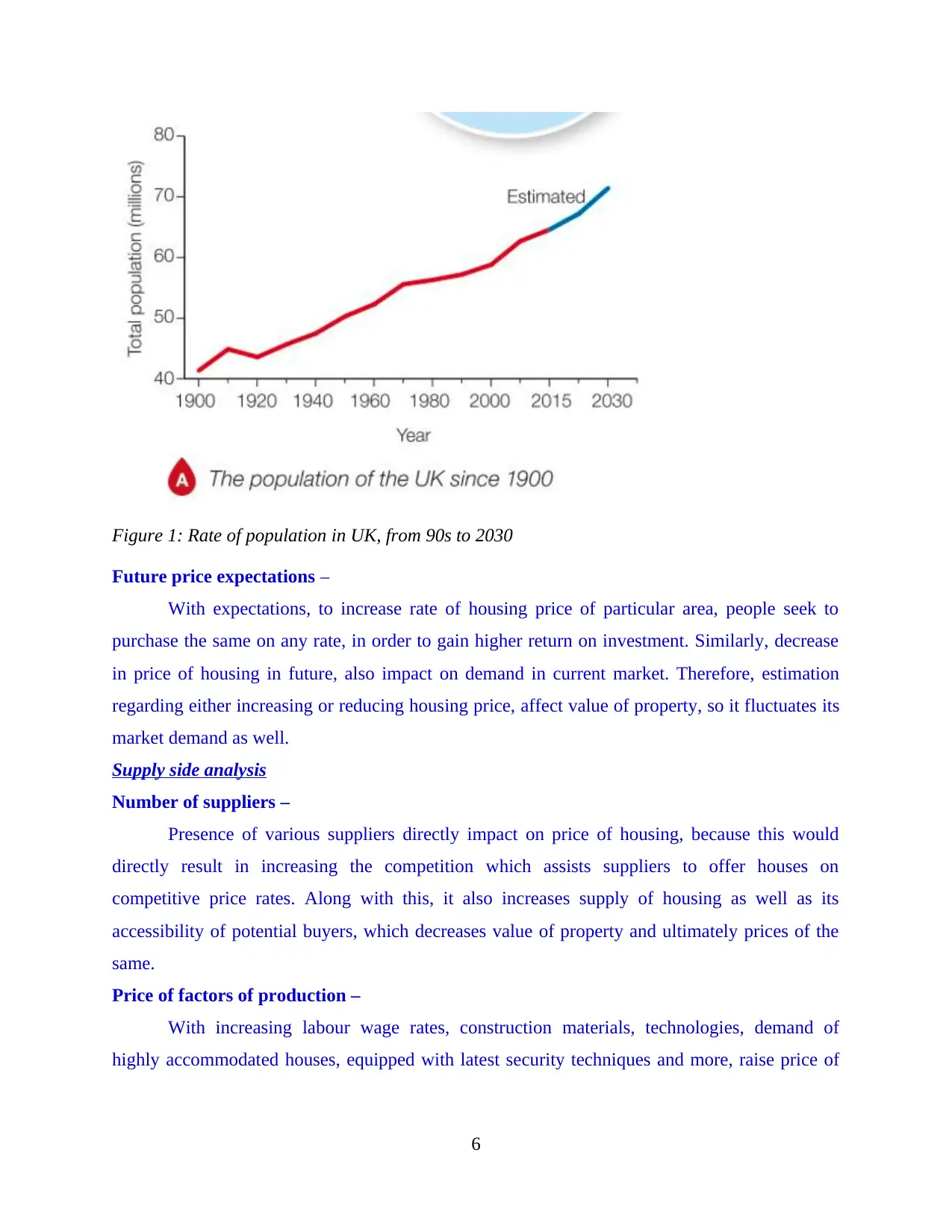
Figure 1: Rate of population in UK, from 90s to 2030
Future price expectations –
With expectations, to increase rate of housing price of particular area, people seek to
purchase the same on any rate, in order to gain higher return on investment. Similarly, decrease
in price of housing in future, also impact on demand in current market. Therefore, estimation
regarding either increasing or reducing housing price, affect value of property, so it fluctuates its
market demand as well.
Supply side analysis
Number of suppliers –
Presence of various suppliers directly impact on price of housing, because this would
directly result in increasing the competition which assists suppliers to offer houses on
competitive price rates. Along with this, it also increases supply of housing as well as its
accessibility of potential buyers, which decreases value of property and ultimately prices of the
same.
Price of factors of production –
With increasing labour wage rates, construction materials, technologies, demand of
highly accommodated houses, equipped with latest security techniques and more, raise price of
6
Future price expectations –
With expectations, to increase rate of housing price of particular area, people seek to
purchase the same on any rate, in order to gain higher return on investment. Similarly, decrease
in price of housing in future, also impact on demand in current market. Therefore, estimation
regarding either increasing or reducing housing price, affect value of property, so it fluctuates its
market demand as well.
Supply side analysis
Number of suppliers –
Presence of various suppliers directly impact on price of housing, because this would
directly result in increasing the competition which assists suppliers to offer houses on
competitive price rates. Along with this, it also increases supply of housing as well as its
accessibility of potential buyers, which decreases value of property and ultimately prices of the
same.
Price of factors of production –
With increasing labour wage rates, construction materials, technologies, demand of
highly accommodated houses, equipped with latest security techniques and more, raise price of
6
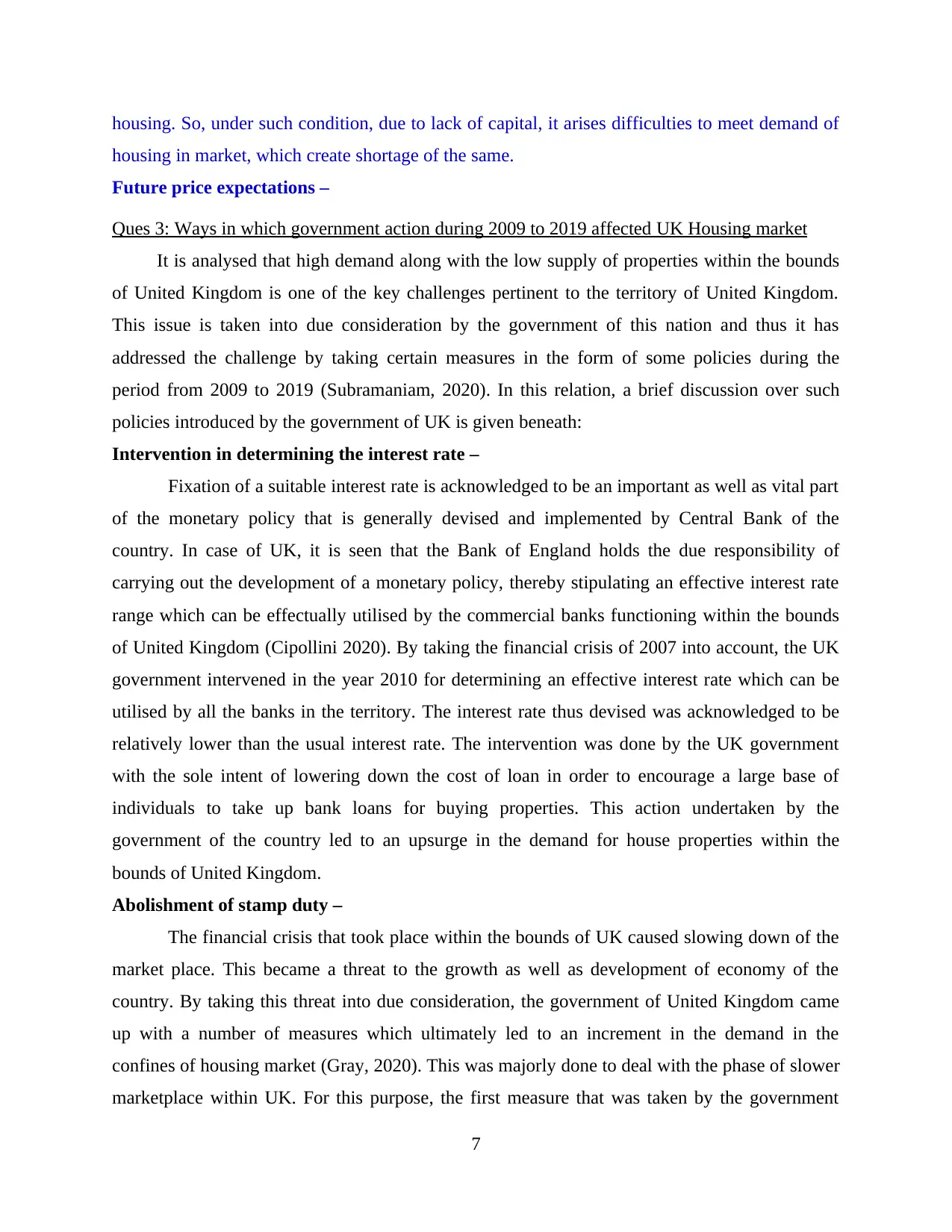
housing. So, under such condition, due to lack of capital, it arises difficulties to meet demand of
housing in market, which create shortage of the same.
Future price expectations –
Ques 3: Ways in which government action during 2009 to 2019 affected UK Housing market
It is analysed that high demand along with the low supply of properties within the bounds
of United Kingdom is one of the key challenges pertinent to the territory of United Kingdom.
This issue is taken into due consideration by the government of this nation and thus it has
addressed the challenge by taking certain measures in the form of some policies during the
period from 2009 to 2019 (Subramaniam, 2020). In this relation, a brief discussion over such
policies introduced by the government of UK is given beneath:
Intervention in determining the interest rate –
Fixation of a suitable interest rate is acknowledged to be an important as well as vital part
of the monetary policy that is generally devised and implemented by Central Bank of the
country. In case of UK, it is seen that the Bank of England holds the due responsibility of
carrying out the development of a monetary policy, thereby stipulating an effective interest rate
range which can be effectually utilised by the commercial banks functioning within the bounds
of United Kingdom (Cipollini 2020). By taking the financial crisis of 2007 into account, the UK
government intervened in the year 2010 for determining an effective interest rate which can be
utilised by all the banks in the territory. The interest rate thus devised was acknowledged to be
relatively lower than the usual interest rate. The intervention was done by the UK government
with the sole intent of lowering down the cost of loan in order to encourage a large base of
individuals to take up bank loans for buying properties. This action undertaken by the
government of the country led to an upsurge in the demand for house properties within the
bounds of United Kingdom.
Abolishment of stamp duty –
The financial crisis that took place within the bounds of UK caused slowing down of the
market place. This became a threat to the growth as well as development of economy of the
country. By taking this threat into due consideration, the government of United Kingdom came
up with a number of measures which ultimately led to an increment in the demand in the
confines of housing market (Gray, 2020). This was majorly done to deal with the phase of slower
marketplace within UK. For this purpose, the first measure that was taken by the government
7
housing in market, which create shortage of the same.
Future price expectations –
Ques 3: Ways in which government action during 2009 to 2019 affected UK Housing market
It is analysed that high demand along with the low supply of properties within the bounds
of United Kingdom is one of the key challenges pertinent to the territory of United Kingdom.
This issue is taken into due consideration by the government of this nation and thus it has
addressed the challenge by taking certain measures in the form of some policies during the
period from 2009 to 2019 (Subramaniam, 2020). In this relation, a brief discussion over such
policies introduced by the government of UK is given beneath:
Intervention in determining the interest rate –
Fixation of a suitable interest rate is acknowledged to be an important as well as vital part
of the monetary policy that is generally devised and implemented by Central Bank of the
country. In case of UK, it is seen that the Bank of England holds the due responsibility of
carrying out the development of a monetary policy, thereby stipulating an effective interest rate
range which can be effectually utilised by the commercial banks functioning within the bounds
of United Kingdom (Cipollini 2020). By taking the financial crisis of 2007 into account, the UK
government intervened in the year 2010 for determining an effective interest rate which can be
utilised by all the banks in the territory. The interest rate thus devised was acknowledged to be
relatively lower than the usual interest rate. The intervention was done by the UK government
with the sole intent of lowering down the cost of loan in order to encourage a large base of
individuals to take up bank loans for buying properties. This action undertaken by the
government of the country led to an upsurge in the demand for house properties within the
bounds of United Kingdom.
Abolishment of stamp duty –
The financial crisis that took place within the bounds of UK caused slowing down of the
market place. This became a threat to the growth as well as development of economy of the
country. By taking this threat into due consideration, the government of United Kingdom came
up with a number of measures which ultimately led to an increment in the demand in the
confines of housing market (Gray, 2020). This was majorly done to deal with the phase of slower
marketplace within UK. For this purpose, the first measure that was taken by the government
7
⊘ This is a preview!⊘
Do you want full access?
Subscribe today to unlock all pages.

Trusted by 1+ million students worldwide
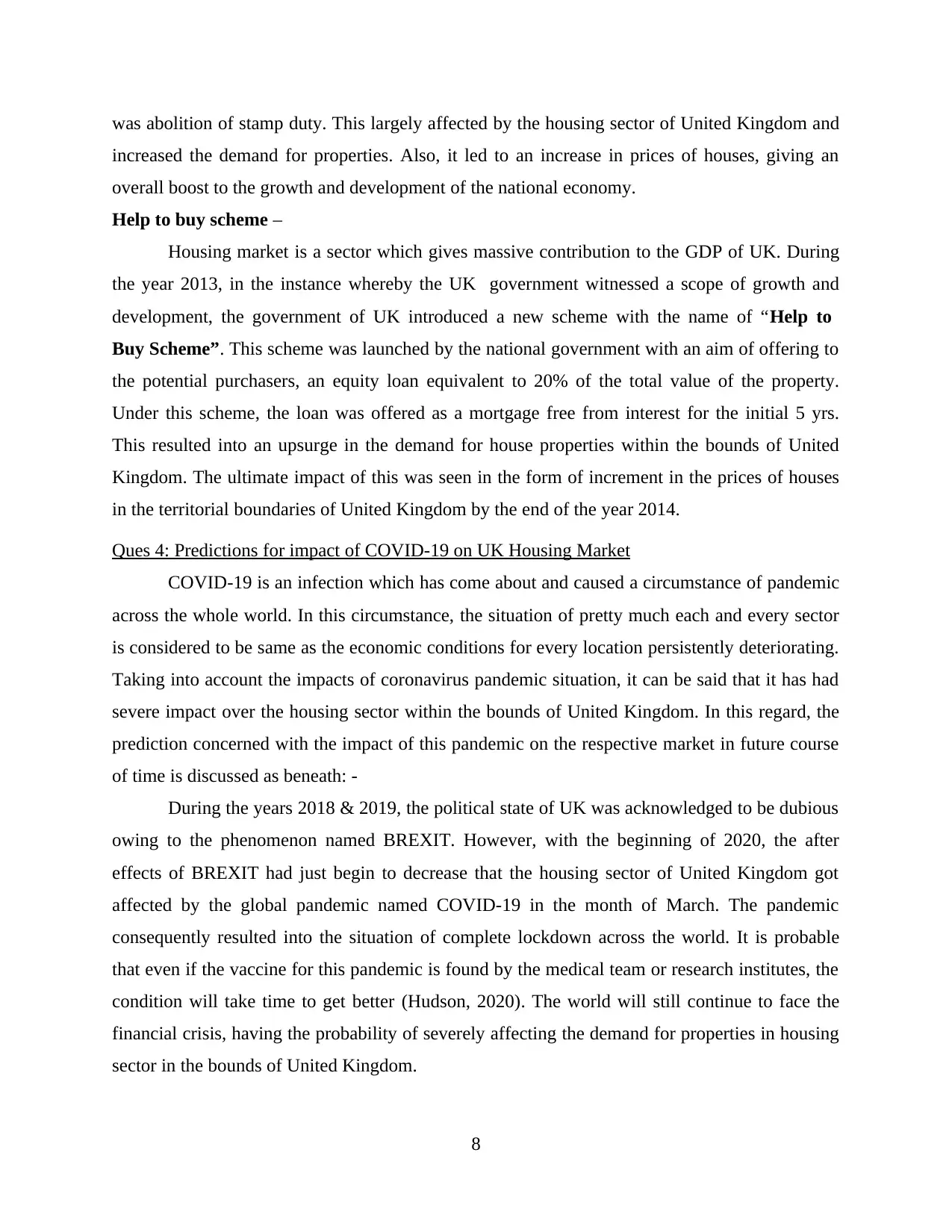
was abolition of stamp duty. This largely affected by the housing sector of United Kingdom and
increased the demand for properties. Also, it led to an increase in prices of houses, giving an
overall boost to the growth and development of the national economy.
Help to buy scheme –
Housing market is a sector which gives massive contribution to the GDP of UK. During
the year 2013, in the instance whereby the UK government witnessed a scope of growth and
development, the government of UK introduced a new scheme with the name of “Help to
Buy Scheme”. This scheme was launched by the national government with an aim of offering to
the potential purchasers, an equity loan equivalent to 20% of the total value of the property.
Under this scheme, the loan was offered as a mortgage free from interest for the initial 5 yrs.
This resulted into an upsurge in the demand for house properties within the bounds of United
Kingdom. The ultimate impact of this was seen in the form of increment in the prices of houses
in the territorial boundaries of United Kingdom by the end of the year 2014.
Ques 4: Predictions for impact of COVID-19 on UK Housing Market
COVID-19 is an infection which has come about and caused a circumstance of pandemic
across the whole world. In this circumstance, the situation of pretty much each and every sector
is considered to be same as the economic conditions for every location persistently deteriorating.
Taking into account the impacts of coronavirus pandemic situation, it can be said that it has had
severe impact over the housing sector within the bounds of United Kingdom. In this regard, the
prediction concerned with the impact of this pandemic on the respective market in future course
of time is discussed as beneath: -
During the years 2018 & 2019, the political state of UK was acknowledged to be dubious
owing to the phenomenon named BREXIT. However, with the beginning of 2020, the after
effects of BREXIT had just begin to decrease that the housing sector of United Kingdom got
affected by the global pandemic named COVID-19 in the month of March. The pandemic
consequently resulted into the situation of complete lockdown across the world. It is probable
that even if the vaccine for this pandemic is found by the medical team or research institutes, the
condition will take time to get better (Hudson, 2020). The world will still continue to face the
financial crisis, having the probability of severely affecting the demand for properties in housing
sector in the bounds of United Kingdom.
8
increased the demand for properties. Also, it led to an increase in prices of houses, giving an
overall boost to the growth and development of the national economy.
Help to buy scheme –
Housing market is a sector which gives massive contribution to the GDP of UK. During
the year 2013, in the instance whereby the UK government witnessed a scope of growth and
development, the government of UK introduced a new scheme with the name of “Help to
Buy Scheme”. This scheme was launched by the national government with an aim of offering to
the potential purchasers, an equity loan equivalent to 20% of the total value of the property.
Under this scheme, the loan was offered as a mortgage free from interest for the initial 5 yrs.
This resulted into an upsurge in the demand for house properties within the bounds of United
Kingdom. The ultimate impact of this was seen in the form of increment in the prices of houses
in the territorial boundaries of United Kingdom by the end of the year 2014.
Ques 4: Predictions for impact of COVID-19 on UK Housing Market
COVID-19 is an infection which has come about and caused a circumstance of pandemic
across the whole world. In this circumstance, the situation of pretty much each and every sector
is considered to be same as the economic conditions for every location persistently deteriorating.
Taking into account the impacts of coronavirus pandemic situation, it can be said that it has had
severe impact over the housing sector within the bounds of United Kingdom. In this regard, the
prediction concerned with the impact of this pandemic on the respective market in future course
of time is discussed as beneath: -
During the years 2018 & 2019, the political state of UK was acknowledged to be dubious
owing to the phenomenon named BREXIT. However, with the beginning of 2020, the after
effects of BREXIT had just begin to decrease that the housing sector of United Kingdom got
affected by the global pandemic named COVID-19 in the month of March. The pandemic
consequently resulted into the situation of complete lockdown across the world. It is probable
that even if the vaccine for this pandemic is found by the medical team or research institutes, the
condition will take time to get better (Hudson, 2020). The world will still continue to face the
financial crisis, having the probability of severely affecting the demand for properties in housing
sector in the bounds of United Kingdom.
8
Paraphrase This Document
Need a fresh take? Get an instant paraphrase of this document with our AI Paraphraser
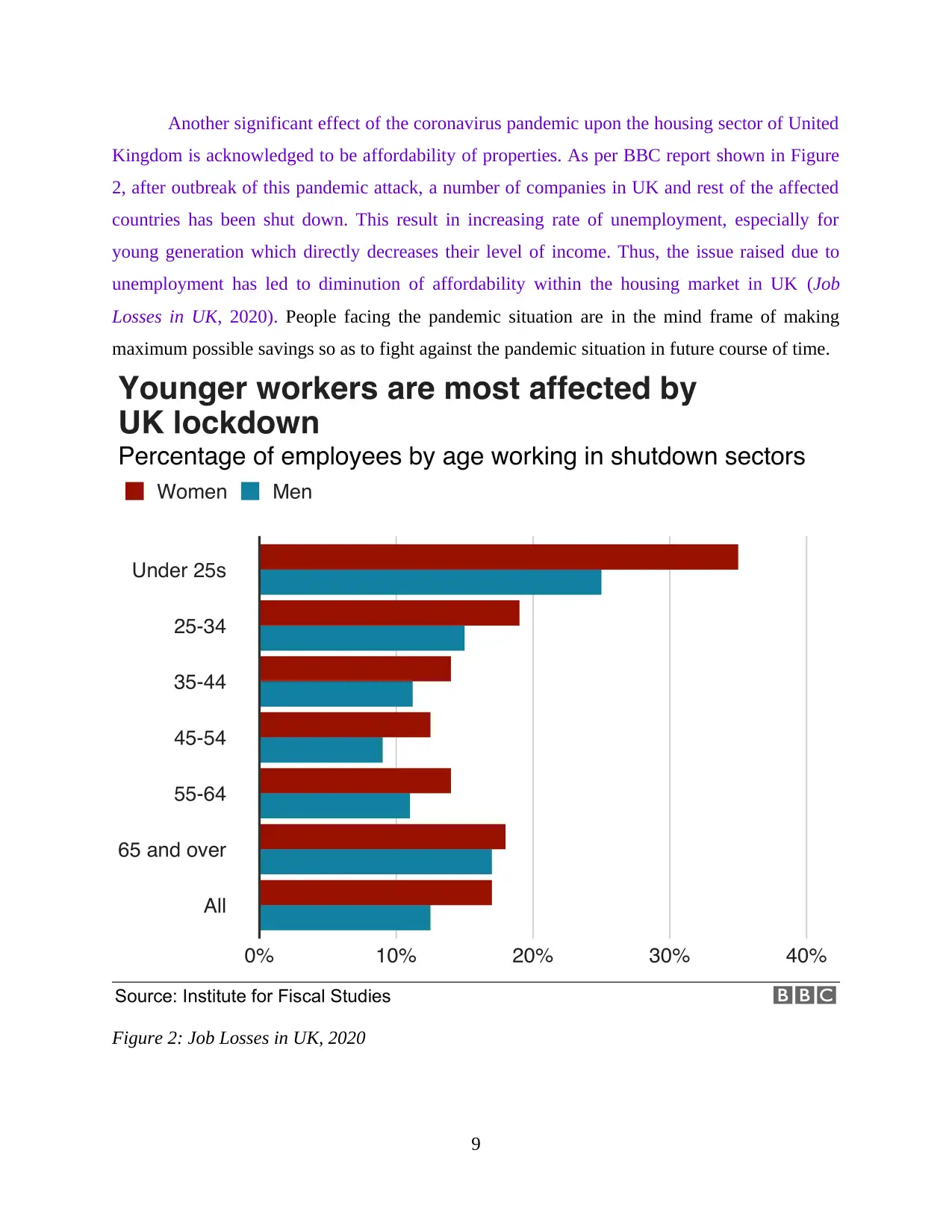
Another significant effect of the coronavirus pandemic upon the housing sector of United
Kingdom is acknowledged to be affordability of properties. As per BBC report shown in Figure
2, after outbreak of this pandemic attack, a number of companies in UK and rest of the affected
countries has been shut down. This result in increasing rate of unemployment, especially for
young generation which directly decreases their level of income. Thus, the issue raised due to
unemployment has led to diminution of affordability within the housing market in UK (Job
Losses in UK, 2020). People facing the pandemic situation are in the mind frame of making
maximum possible savings so as to fight against the pandemic situation in future course of time.
Figure 2: Job Losses in UK, 2020
9
Kingdom is acknowledged to be affordability of properties. As per BBC report shown in Figure
2, after outbreak of this pandemic attack, a number of companies in UK and rest of the affected
countries has been shut down. This result in increasing rate of unemployment, especially for
young generation which directly decreases their level of income. Thus, the issue raised due to
unemployment has led to diminution of affordability within the housing market in UK (Job
Losses in UK, 2020). People facing the pandemic situation are in the mind frame of making
maximum possible savings so as to fight against the pandemic situation in future course of time.
Figure 2: Job Losses in UK, 2020
9
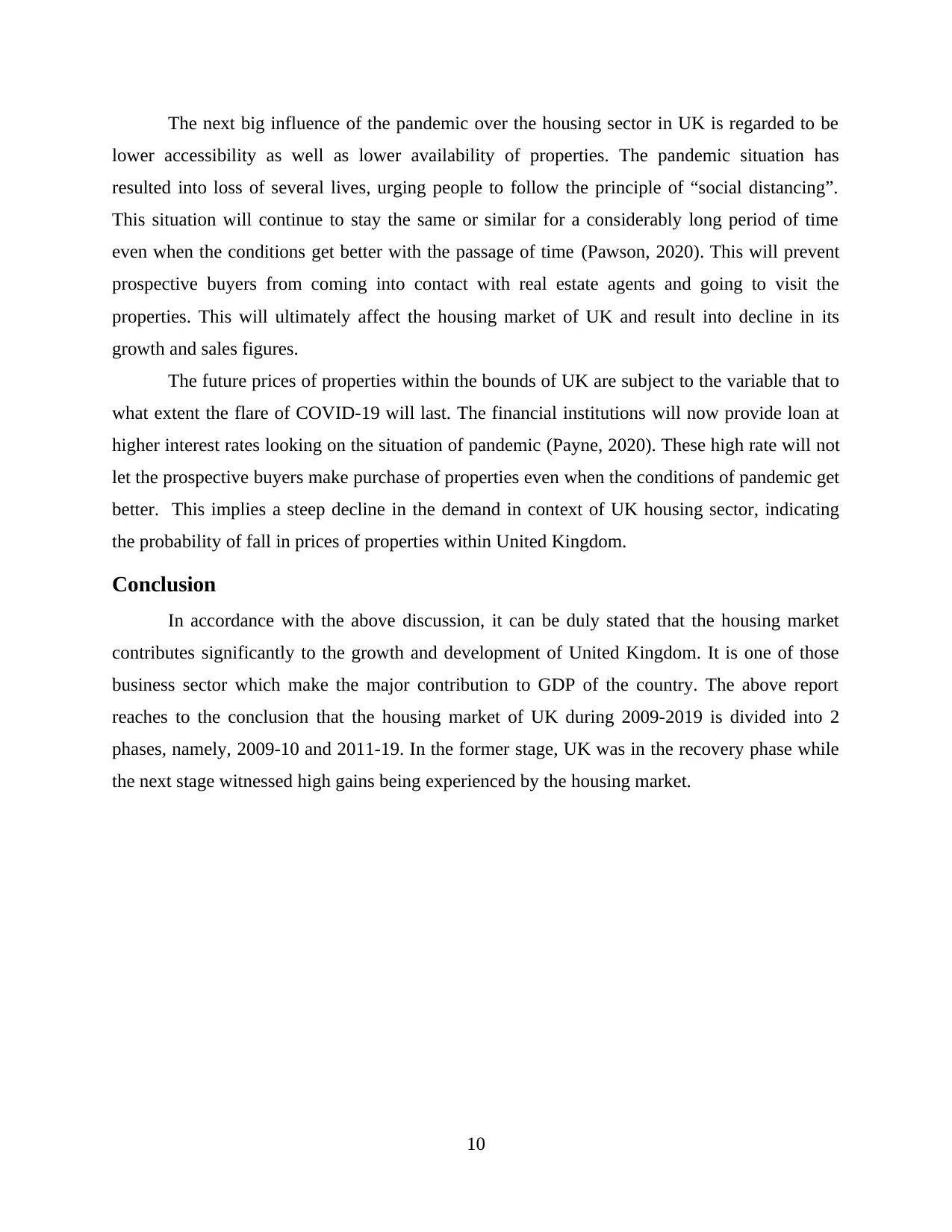
The next big influence of the pandemic over the housing sector in UK is regarded to be
lower accessibility as well as lower availability of properties. The pandemic situation has
resulted into loss of several lives, urging people to follow the principle of “social distancing”.
This situation will continue to stay the same or similar for a considerably long period of time
even when the conditions get better with the passage of time (Pawson, 2020). This will prevent
prospective buyers from coming into contact with real estate agents and going to visit the
properties. This will ultimately affect the housing market of UK and result into decline in its
growth and sales figures.
The future prices of properties within the bounds of UK are subject to the variable that to
what extent the flare of COVID-19 will last. The financial institutions will now provide loan at
higher interest rates looking on the situation of pandemic (Payne, 2020). These high rate will not
let the prospective buyers make purchase of properties even when the conditions of pandemic get
better. This implies a steep decline in the demand in context of UK housing sector, indicating
the probability of fall in prices of properties within United Kingdom.
Conclusion
In accordance with the above discussion, it can be duly stated that the housing market
contributes significantly to the growth and development of United Kingdom. It is one of those
business sector which make the major contribution to GDP of the country. The above report
reaches to the conclusion that the housing market of UK during 2009-2019 is divided into 2
phases, namely, 2009-10 and 2011-19. In the former stage, UK was in the recovery phase while
the next stage witnessed high gains being experienced by the housing market.
10
lower accessibility as well as lower availability of properties. The pandemic situation has
resulted into loss of several lives, urging people to follow the principle of “social distancing”.
This situation will continue to stay the same or similar for a considerably long period of time
even when the conditions get better with the passage of time (Pawson, 2020). This will prevent
prospective buyers from coming into contact with real estate agents and going to visit the
properties. This will ultimately affect the housing market of UK and result into decline in its
growth and sales figures.
The future prices of properties within the bounds of UK are subject to the variable that to
what extent the flare of COVID-19 will last. The financial institutions will now provide loan at
higher interest rates looking on the situation of pandemic (Payne, 2020). These high rate will not
let the prospective buyers make purchase of properties even when the conditions of pandemic get
better. This implies a steep decline in the demand in context of UK housing sector, indicating
the probability of fall in prices of properties within United Kingdom.
Conclusion
In accordance with the above discussion, it can be duly stated that the housing market
contributes significantly to the growth and development of United Kingdom. It is one of those
business sector which make the major contribution to GDP of the country. The above report
reaches to the conclusion that the housing market of UK during 2009-2019 is divided into 2
phases, namely, 2009-10 and 2011-19. In the former stage, UK was in the recovery phase while
the next stage witnessed high gains being experienced by the housing market.
10
⊘ This is a preview!⊘
Do you want full access?
Subscribe today to unlock all pages.

Trusted by 1+ million students worldwide
1 out of 13
Related Documents
Your All-in-One AI-Powered Toolkit for Academic Success.
+13062052269
info@desklib.com
Available 24*7 on WhatsApp / Email
![[object Object]](/_next/static/media/star-bottom.7253800d.svg)
Unlock your academic potential
Copyright © 2020–2025 A2Z Services. All Rights Reserved. Developed and managed by ZUCOL.





